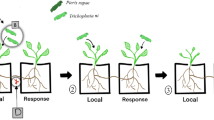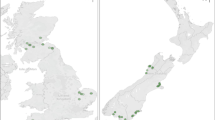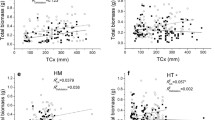Summary
Although insect herbivores have many well documented effects on plant performance, there are few studies that assess the impact of above-ground herbivory on below-ground plant growth. For a seven year period in which no large-scale herbivore outbreaks occurred, a broad spectrum insecticide was utilized to suppress herbivorous insects in a natural community dominated by Solidago altissima. Ramet heights, rhizome lengths, rhizome biomass, and the number of daughter rhizomes all were lower in the control plots than in the insecticidetreated plots. These effects should lead to a decrease in the fitness of genets in the control plots relative to the fitness of genets in the insecticide-treated plots. We also found that ramets in the control plots appear to have compensated for herbivory: the ratio of rhizome length to rhizome biomass was greatest in the control plots, which indicates that clones moved farther per unit biomass in these plots than in the insecticide-treated plots. Clonal growth models show that this shift in allocation patterns greatly reduced the magnitude of treatment differences in long-term clonal displacements.
Previous work has shown, and this study verified, that clonal growth in S. altissima is well represented by random-walk and diffusion models. Therefore, we used these models to examine possible treatment differences in rates of clonal expansion. Although rhizome lengths were greater in the insecticide-treated plots, results from the models suggest that our treatments had little impact on the short- and long-term displacement of S. altissima ramets from a point of origin. This occurred because S. altissima ramets backtrack often, and thus, treatment differences in net displacements are less pronounced than treatment differences in rhizome lengths.
Similar content being viewed by others
References
Angevine MW, Handel SN (1986) Invasion of forest floor space, clonal architecture, and population growth in the perennial herb Clintonia borealis. J Ecol 74: 547–560
Ashmun JW, Pitelka LF (1985) Population biology of Clintonia borealis. II. survival and growth of transplanted ramets in different environments. J Ecol 73: 185–198
Belsky AJ (1986) Does herbivory benefit plants? A review of the evidence. Am Natural 127: 870–892
Bentley S, Whittaker JB (1979) Effects of grazing by a chrysomelid beetle, Gastrophysa viridula on competition between Rumex obtusifolius and Rumex crispus. J Ecol 67: 79–90
Berg GL, ed. (1984) Fenvalerate. Farm Chemical Handbook. Meisler Publishing Company, Willoughby, Ohio, pp. C101-C102
Bradbury IK, Hofstra G (1976) The partitioning of net energy resources in two populations of Solidago canadensis during a single developmental cycle in southern Ontario. Can J Bot 54: 2449–2456
Burton RL (1986) Effect of greenbug (Homoptera: Aphididae) damage on root and shoot biomass of wheat seedlings. J Econ Entomol 79: 633–636
Cain ML (1990a) Patterns of Solidago altissima ramet growth and mortality: the role of below-ground ramet connections. Oecologia 82: 201–209
Cain ML (1990b) Models of clonal growth in Solidago altissima. J Ecol 78: 27–46
Cain ML (1991) When do treatment differences in movement behaviors produce observable differences in long-term displacements? Ecology 72 (in press, no page numbers yet)
Carson WP, Barrett GW (1988) Succession in old-field plant communities: effects of contrasting types of nutrient enrichment. Ecology 69: 984–994
Carson WP, Pickett STA (1990) Role of resources and disturbance in the organization of an old-field plant community. Ecology 71: 226–238
Castro AM, Rumi CP, Arriaga HO (1988) Influence of greenbug on root growth of resistant and susceptible barley genotypes. Environ Exp Bot 28: 61–72
Crawley MJ (1983) Herbivory: the dynamics of animal-plant interactiosn. University of California Press, Berkeley
Crawley MJ (1985) Reduction of oak fecundity by low-density herbivore populations. Nature 314: 163–164
Ginzo HD, Lovell PH (1973) Aspects of the comparative physiology of Ranunculus bulbosus L. and Ranunculus repens L. I. Response to nitrogen. An Bot 37: 753–764
Goldberg DE (1988) Response of Solidago canadensis clones to competition. Oecologia 77: 357–364
Goldberg DE, Miller TE (1990) Effects of different resource additions on species diversity in an annual plant community. Ecology 71: 213–225
Hartnett DC, Bazzaz FA (1983) Physiological integration among intraclonal ramets in Solidago canadensis. Ecology 64: 779–788
Hartnett DC, Bazzaz FA (1985) The integration of neighbourhood effects by clonal genets in Solidago canadensis. J Ecol 73: 415–427
Johnson KB, Radcliffe EB, Teng PS (1986) Effects of interacting populations of Alternaria solani, Verticillium dahliae, and the potato leafhopper (Empoasca fabae) on potato yield. Phytopathology 76: 1046–1052
Jones VP, Toscano NC, Johnson MW, Wetter SC, Youngman RR (1986) Pesticide effects on plant physiology: integration into a pest management scheme. Bull Entomol Soc Am (1986): 103–109
Kareiva PM, Shigesada N (1983) Analyzing insect movement as a correlated random walk. Oecologia 56: 234–238
Kathju S, Shankarnarayan KA, Vyas SP, Lahiri AN (1985) Growth of roots and rhizomes in two desert grasses as influenced by defoliation stress and nitrogen application. Annals Arid Zone 24: 87–93.
Louda SM (1982) Distribution ecology: variation in plant recruitment over a gradient in relation to seed predation. Ecol Monogr 52: 25–41
Lovett Doust L (1981) Population dynamics and local specialization in a clonal perenial (Ranunculus repens). I. The dynamics of ramets in contrasting habitats. J Ecol 69: 743–755
Lubbers AE, Lechowicz MJ (1989) Effects of leaf removal on reproduction vs. below ground storage in Trillium grandiflorum. Ecology 70: 85–96
Maddox GD, Cook RE, Wimberger PH, Gardescu S (1989) Clone structure in four Solidago altissima populations: rhizome connections within genotypes. Am J Bot 76: 318–326
Marquis RJ (1984) Leaf herbivores decrease fitness of a tropical plant. Science 226: 537–539
Marsh LM, Jones RE (1988) The form and consequences of random walk movement models. J Theor Biol 133: 113–131
Mattson WJ Jr (1980) Herbivory in relation to plant nitrogen content. Ann Rev Ecol Syst 11: 119–161
McCulloch CE, Cain ML (1989) Analyzing discrete movement data as a correlated random walk. Ecology 70: 383–388
Mihaliak CA, Lincoln DE (1989) Plant biomass partitioning and chemical defense: response to defoliation and nitrate limitation. Oecologia 80: 122–126
Moran NA, Whitham TG (1990) Interspecific competition between rootfeeding and leaf-galling aphids mediated by host-plant resistance. Ecology 71: 1050–1058
Okubo A (1980) Diffusion and ecological problems: mathematical models. Springer, Berlin, Heidelberg, New York, USA
Parker MA, Root RB (1981) Insect herbivores limit habitat distribution of a native composite Machaeranthera canescens. Ecology 62: 1390–1392
Salisbury EJ (1942) The reproductive capacity of plants. Bell, London
Schmid B., Puttick GM, Burgess KH, Bazzaz FA. 1988. Clonal integration and effects of simulated herbivory in old-field perennials. Oecologia 75: 465–471
Slade AJ, Hutchings MJ (1987a) The effects of nutrient availability on foraging in the clonal herb Glechoma hederacea. J Ecol 75: 95–112
Slade AJ, Hutchings MJ (1987b) The effects of light intensity on foraging in the clonal herb Glechoma hederacea. J Ecol 75: 639–650
Werner PA, Bradbury IK, Gross RS (1980) The biology of Canadian weeds. 45. Solidago canadensis L. Canad J Plant Sci 60: 1393–1409
Author information
Authors and Affiliations
Rights and permissions
About this article
Cite this article
Cain, M.L., Carson, W.P. & Root, R.B. Long-term suppression of insect herbivores increases the production and growth of Solidago altissima rhizomes. Oecologia 88, 251–257 (1991). https://doi.org/10.1007/BF00320819
Received:
Accepted:
Issue Date:
DOI: https://doi.org/10.1007/BF00320819




